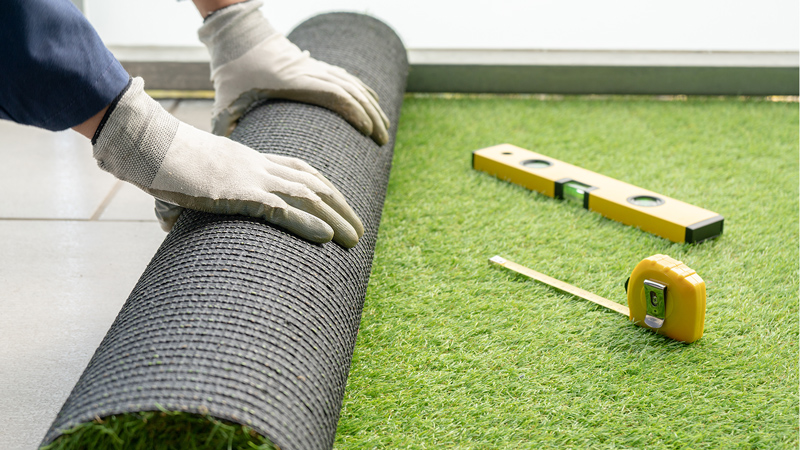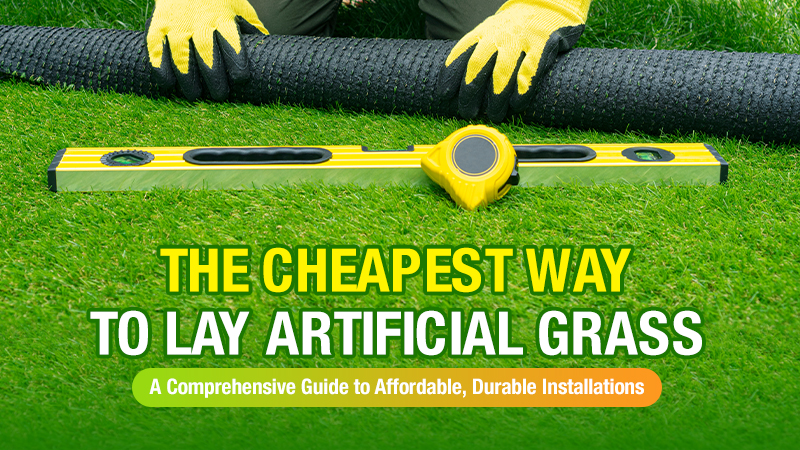How Much Does Artificial Grass Cost? Understand Artificial Grass Prices in 2025
- 08/14/2025
Below is a summary table highlighting the most frequently asked question “How Much does Artificial Grass Cost?” or “What is the Price of Artificial Grass?”. Just check it to understand the artificial grass prices. (Note: these are illustrative examples and may vary based on region and supplier):
| Quality level | Recommended Applications | Features of artificial turf | Cost of artificial grass (Per sq. ft.) | Installation cost (Per sq. ft.) | Total cost (Per sq. ft.) |
| Basic turf | Indoor decorative use, low traffic areas | Low pile height and density | $2–$5 | $10–$20 | $12–$25 |
| Mid-level turf | Outdoor residential lawns for landscaping, moderate use frequency | Moderate pile height, durable and realistic | $4–$8 | $10–$20 | $14–$28 |
| Premium turf | Heavy traffic areas such as playgrounds, public and community areas | Better quality and high density, suitable for heavy foot traffic | $5–$10 | $10–$20 | $15–$30 |
Overall, artificial grass costs from $12 to $30 per sq.ft, including the turf material itself and the installation costs.
Let’s take an example. If you are ready to lay grass lawn for an outdoor garden of 400 sq.ft, we will recommend a mid-level 30mm pile height grass, it will cost about $5,600–$11,200.
In this article:
1. Key Factors That Influence Artificial Grass Prices
The price of artificial grass is rarely a fixed number. Instead, it’s shaped by multiple factors, from material quality to installation complexity. Below are the primary considerations:
1.1 Material Quality and Durability
High-quality synthetic turf is designed to withstand heavy foot traffic, UV exposure, and weather extremes. Premium-level turfs use advanced polymers like polyethene or polypropylene, which mimic the softness and resilience of natural grass.
Lower-cost options may use less durable materials, leading to faster wear and tear. While initial costs for premium turf are higher, its longevity often justifies the investment.
1.2 Pile Height and Density
Artificial grass with a taller pile height (e.g., 30–40mm) and dense fibers looks lush and natural but costs more due to higher material usage. Shorter, less dense turf (e.g., 20–25mm) is more affordable but may lack durability. For high-traffic areas like playgrounds or commercial spaces, denser turf is recommended.
1.3 Yarn Shape and Texture
Modern synthetic grass features different yarn shapes. Flat blades are often cost-effective but less realistic. C-shaped or diamond-shaped fibers provide bounce and a natural appearance. Multi-tone fibers mimicate the color variations of real grass. Textured yarns enhance aesthetics but often come at a premium.
1.4 Backing and Drainage Systems
A robust backing system ensures durability and proper drainage. High-end turf includes multiple layers (e.g., latex backing with perforations) to prevent water pooling. Cheaper alternatives may compromise on drainage, risking mould growth or surface damage.
1.5 Installation Complexity
Labour costs vary depending on factors like surface preparation (removing existing grass, leveling, or adding weed barriers), sub-base materials (crushed rock or sand for stability), and customisation (curves, slopes, or integrating features like pavers).
While DIY installations reduce labor expenses, they demand technical expertise to ensure proper execution.
1.6 Quantity and Project Scale
Bulk purchases often qualify for discounts. For example, covering a 500 sq.ft. Backyard may cost less per square foot than a 50 sq.ft. balcony due to economies of scale.
2. Price Comparisons by Application
Artificial grass costs differ based on its intended use. Below are common scenarios:
2.1 Residential Lawns
Homeowners prioritize aesthetics and comfort. Mid-range turf with moderate pile height (25–35mm) and UV resistance is ideal for gardens or backyards. Costs rise if the project includes intricate designs or slopes.
2.2 Commercial Spaces
Offices, hotels, and restaurants often choose durable, high-density turf to handle heavy foot traffic. Flame-retardant or antimicrobial options are specially designed for public areas, which may add to the price.
2.3 Playgrounds and Pet Areas
Safety is critical for the turf surface for kid or pet areas. Turf with non-abrasive fibers, antibacterial coatings, Health Protector, and efficient drainage systems ensures a hygienic surface but comes at a premium.
2.4 Sports Fields
Specialized sports turf requires shock-absorbing pads, reinforced seams, and FIFA-certified materials. These features significantly increase costs compared to standard landscape turf.
3. Hidden Costs and Long-Term Value
While upfront costs are a primary concern, considering long-term savings ensures a smarter investment:
3.1 Maintenance Expenses
Artificial grass eliminates watering, mowing, and fertilizing costs. However, occasional brushing, rinsing, and infill top-ups are recommended. Budget for a garden hose, and stiff brush.
3.2 Warranty and Lifespan
Premium astro turf often includes 8–15-year warranties, reflecting confidence in its durability. Cheaper turfs may last only 5–8 years, leading to replacement costs.
3.3 Energy and Water Savings
Reduced water usage lowers utility bills, especially in arid regions. Synthetic lawns also minimize the need for gas-powered lawn equipment.
4. How to Budget for Artificial Grass
Follow these steps to estimate costs accurately:
Measure the Area: Calculate square footage to avoid over- or under-ordering.
Choose the Right Turf: Match pile height, density, and features to your needs.
Get Multiple Quotes: Compare different turf suppliers for competitive pricing.
Factor in Extras: Include infill, adhesives, and delivery fees.
Plan for Contingencies: Set aside 10–15% of the budget for unexpected expenses.
5. Cost-Saving Tips Without Sacrificing Quality
Opt for Mid-Range Turf: Balance quality and affordability.
DIY Installation: If you’re skilled, handle site preparation and laying the turf yourself.
Seasonal Discounts: Artificial turf suppliers may offer deals during off-peak months.
Repurpose Materials: Use recycled rubber infill or reclaimed sub-base materials.
Click the image below to explore The Cheapest Way to Lay Artificial Grass and discover more smart ways to save.
6. Frequently Asked Questions
Q: Is artificial grass more expensive than natural grass?
A: Initially, yes. However, synthetic turf saves money over time by eliminating maintenance costs.
Q: Can I install artificial grass over concrete?
A: Yes, but a shock-absorbing underlay is recommended for comfort and drainage, especially for a pet’s area or a kid’s playground.
Q: How often should I replace artificial grass?
A: High-quality turf lasts 10+ years with proper care.
Q: How much does artificial turf cost for a football field?
A: The cost of installing artificial turf on sports fields depends on factors like turf type, field dimensions, and installation services. For a standard-sized football or soccer field, the cost can be from $500,000 to $1,000,000. This comprehensive price includes site preparation, drainage and synthetic turf installation.
7. Conclusion
This comprehensive guide equips you with the knowledge to navigate artificial grass costs confidently. By focusing on quality, application-specific needs, and smart budgeting, you’ll achieve a vibrant, low-maintenance turf surface that delivers lasting value.
Final Tip: Always request samples to assess quality before purchasing. This small step helps avoid costly mismatches between expectations and reality.






